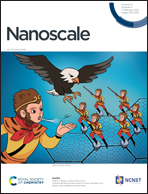The influence of thermal treatment conditions (solvothermal versus microwave) and solvent polarity on the morphology and emission of phloroglucinol-based nitrogen-doped carbon dots†
Abstract
The optical properties of chemically synthesized carbon dots (CDs) can be widely tuned via doping and surface modification with heteroatoms such as nitrogen, which results in a range of potential applications. Herein, two most commonly used synthesis approaches, namely, solvothermal and microwave-assisted thermal treatments, have been used for the preparation of CDs from phloroglucinol using three different nitrogen containing solvents, namely, ethylenediamine, dimethylformamide, and formamide. Based on the analysis of the morphology and optical properties, we demonstrate the tenability of the CD appearance from amorphous or well-carbonized spherical particles to onion-like ones, which is controlled by solvent polarity, whereas the thermal treatment conditions mostly influence the degree of N-doping and the nature of emissive centers of CDs formed. The findings of this study expand the toolkit of the available CDs with variable morphology and energy structure.



 Please wait while we load your content...
Please wait while we load your content...